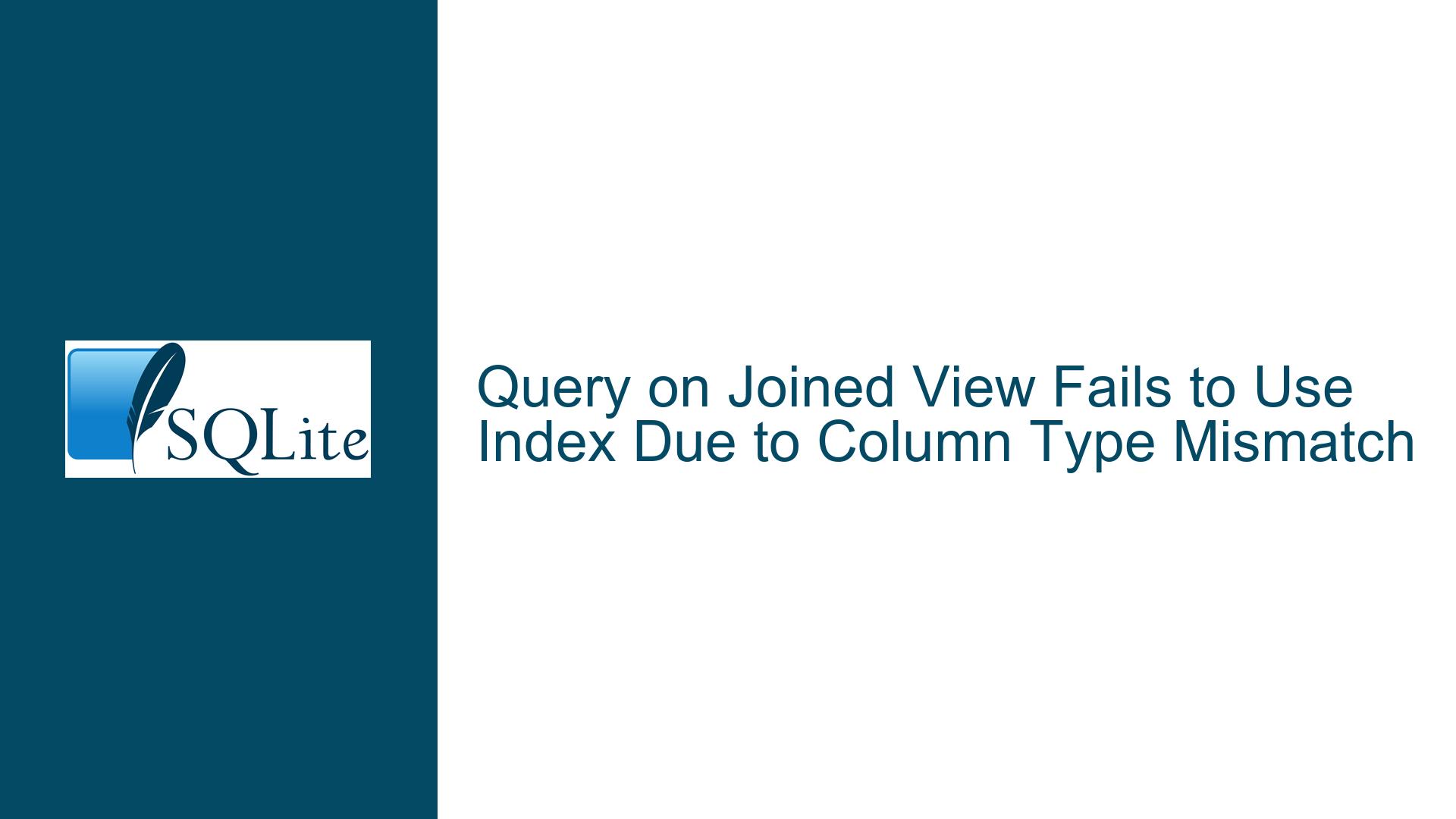Query on Joined View Fails to Use Index Due to Column Type Mismatch
Issue Overview: Join Condition Column Type Affinity Mismatch Prevents Index Utilization in SQLite Views
When executing a SELECT query against a view that joins two tables via an indexed column, SQLite may fail to utilize available indexes if there is a mismatch in column type affinity between the joined columns. This occurs even when the columns are logically related through foreign key references or join conditions. The problem manifests specifically in scenarios where:
- A parent table declares a column with an explicit
INTEGER PRIMARY KEY(rowid alias) - A child table references this column via a foreign key but omits explicit type declaration
- An index exists on the child table’s foreign key column
- A view combines both tables via an
INNER JOINon these columns - Queries filter results using the parent table’s primary key column instead of the child table’s indexed foreign key
In the reported case, filtering by parent.id (explicit INTEGER) forced a full SCAN of the child table despite an existing index on child.parent_id, while filtering by child.parent_id (undeclared type) properly utilized the index. This discrepancy stems from SQLite’s type affinity system and the query optimizer’s inability to recognize equivalence between columns with differing affinities during view flattening.
Key technical relationships:
- Parent table’s
idhasINTEGERaffinity due toINTEGER PRIMARY KEYdeclaration - Child table’s
parent_idhasNUMERICaffinity (default when no type specified) - View’s join condition
parent.id = child.parent_idcreates implicit type conversion - Query planner cannot propagate value constraints across affinity-mismatched join columns
Possible Causes: Type Affinity Conflicts and Constraint Propagation Limitations in View Optimization
1. Implicit Type Conversion Disrupts Index Eligibility
SQLite employs type affinity rather than rigid type checking. When comparing values between columns with different affinities:
INTEGER-affinity columns store values as 64-bit signed integersNUMERIC-affinity columns may store values as integers or doubles- Comparison between
INTEGERandNUMERICrequires runtime type coercion
This coercion prevents the query optimizer from recognizing that a filter on parent.id (INTEGER) could be translated to an equivalent filter on child.parent_id (NUMERIC). The index on child.parent_id becomes unusable because:
- Index entries store raw NUMERIC-affinity values
- Search key from parent.id provides INTEGER values
- Direct comparison without conversion would miss matches
- Conversion would require evaluating every index entry
2. View Flattening Fails to Unify Column Constraints
SQLite attempts to "flatten" views by merging their definition into the outer query. Successful flattening allows:
- Propagation of WHERE clause constraints to base tables
- Recognition of indexed column equivalences
- Join order optimization
Flattening fails when the view contains:
- Compound queries (UNION/INTERSECT)
- Aggregate functions
- Subqueries in SELECT list
- Certain forms of joins
In this case, view flattening succeeds but constraint propagation fails due to:
- Mismatched type affinities between joined columns
- Lack of explicit type casts in view definition
- Impossibility of guaranteeing value equivalence post-conversion
3. Foreign Key Type Inference Limitations
Though foreign keys create logical relationships, SQLite:
- Does not enforce column type matching
- Does not automatically align affinities
- Treats foreign key references as independent of column affinity
Thus, a foreign key reference from child.parent_id to parent.id:
- Creates constraint validation at write time
- Does NOT create type equivalence at schema level
- Does NOT influence query optimizer’s affinity handling
Troubleshooting Steps, Solutions & Fixes: Aligning Column Affinities and Optimizing View Queries
Step 1: Diagnose Column Affinity Mismatches
A. Retrieve Column Affinities
-- Parent table schema
SELECT name, type, "notnull" FROM pragma_table_info('parent');
-- Child table schema
SELECT name, type, "notnull" FROM pragma_table_info('child');
B. Analyze Affinity Relationships
parent.id: TypeINTEGER→ INTEGER affinitychild.parent_id: Type omitted → NUMERIC affinity
C. Verify Index Utilization Discrepancy
-- Filter by child.parent_id (uses index)
EXPLAIN QUERY PLAN
SELECT * FROM parent_child WHERE parent_id = ?;
-- Filter by parent.id (full scan)
EXPLAIN QUERY PLAN
SELECT * FROM parent_child WHERE id = ?;
Step 2: Align Column Affinities Through Schema Modification
A. Modify Child Table Definition
-- Drop existing constraints
PRAGMA foreign_keys=OFF;
BEGIN TRANSACTION;
-- Create replacement table with explicit type
CREATE TABLE new_child (
parent_id INTEGER REFERENCES parent(id),
PRIMARY KEY(parent_id)
);
-- Copy data
INSERT INTO new_child SELECT * FROM child;
-- Drop old table
DROP TABLE child;
-- Rename new table
ALTER TABLE new_child RENAME TO child;
COMMIT;
PRAGMA foreign_keys=ON;
B. Verify Updated Affinities
SELECT name, type FROM pragma_table_info('child');
-- Should show 'parent_id' with INTEGER type
C. Rebuild Indexes
REINDEX child_index1;
Step 3: Optimize View Queries With Explicit Casting
A. Modify View Definition (If Schema Change Not Possible)
DROP VIEW parent_child;
CREATE VIEW parent_child AS
SELECT parent.*,
child.parent_id CAST AS INTEGER,
child.other_columns
FROM parent
INNER JOIN child ON parent.id = child.parent_id;
B. Verify Constraint Propagation
EXPLAIN QUERY PLAN
SELECT * FROM parent_child WHERE id = ?;
-- Should now show SEARCH on child using index
Step 4: Utilize Index Hints as Temporary Workaround
A. Force Index Usage via INDEXED BY
SELECT parent.*, child.*
FROM parent
INNER JOIN child INDEXED BY child_index1
ON child.parent_id = parent.id
WHERE parent.id = ?;
B. Monitor Performance Characteristics
-- Compare execution times
.timer on
-- Original query
SELECT * FROM parent_child WHERE id = ?;
-- Index-hinted query
SELECT /*+ INDEXED_BY(child_index1) */ *
FROM parent_child WHERE id = ?;
Step 5: Implement Comprehensive Type Consistency Checks
A. Schema Validation Script
SELECT
m.name AS table_name,
p.name AS column_name,
p.type AS declared_type,
CASE
WHEN p.pk > 0 THEN 'PRIMARY KEY'
WHEN fk.table IS NOT NULL THEN 'FOREIGN KEY'
ELSE ''
END AS constraints,
CASE p.type
WHEN 'INTEGER' THEN 'INTEGER'
WHEN 'TEXT' THEN 'TEXT'
WHEN 'REAL' THEN 'REAL'
WHEN 'BLOB' THEN 'BLOB'
WHEN 'NUMERIC' THEN 'NUMERIC'
ELSE 'NUMERIC'
END AS inferred_affinity
FROM sqlite_master AS m
JOIN pragma_table_info(m.name) AS p
LEFT JOIN pragma_foreign_key_list(m.name) AS fk
ON fk."from" = p.name
WHERE m.type = 'table';
B. Automated Affinity Alignment Recommendations
# Pseudocode for detecting affinity mismatches in foreign keys
import sqlite3
def check_affinity_mismatches(db_path):
conn = sqlite3.connect(db_path)
cursor = conn.cursor()
# Get all foreign key relationships
cursor.execute("""
SELECT m.name AS table_name,
fk."from" AS column_name,
fk."table" AS referenced_table,
fk."to" AS referenced_column
FROM sqlite_master AS m
JOIN pragma_foreign_key_list(m.name) AS fk
WHERE m.type = 'table'
""")
fks = cursor.fetchall()
for fk in fks:
# Get column affinities
cursor.execute(f"PRAGMA table_info({fk[0]})")
cols = {row[1]: row[2] for row in cursor.fetchall()}
from_affinity = determine_affinity(cols[fk[1]])
cursor.execute(f"PRAGMA table_info({fk[2]})")
cols_ref = {row[1]: row[2] for row in cursor.fetchall()}
to_affinity = determine_affinity(cols_ref[fk[3]])
if from_affinity != to_affinity:
print(f"Affinity mismatch in {fk[0]}.{fk[1]} ({from_affinity}) "
f"-> {fk[2]}.{fk[3]} ({to_affinity})")
def determine_affinity(decl_type):
decl_type = (decl_type or '').upper().split('(')[0]
return {
'INT': 'INTEGER',
'INTEGER': 'INTEGER',
'TINYINT': 'INTEGER',
'SMALLINT': 'INTEGER',
'MEDIUMINT': 'INTEGER',
'BIGINT': 'INTEGER',
'UNSIGNED BIG INT': 'INTEGER',
'VARCHAR': 'TEXT',
'CLOB': 'TEXT',
'TEXT': 'TEXT',
'FLOAT': 'REAL',
'DOUBLE': 'REAL',
'REAL': 'REAL',
'NUMERIC': 'NUMERIC',
'DECIMAL': 'NUMERIC',
'BOOLEAN': 'NUMERIC',
'DATE': 'NUMERIC',
'DATETIME': 'NUMERIC'
}.get(decl_type, 'NUMERIC')
Step 6: Advanced Optimization with Materialized Views
A. Create Indexed Materialized View
-- For read-heavy workloads
CREATE TABLE parent_child_materialized (
id INTEGER PRIMARY KEY,
parent_id INTEGER,
-- Other columns
_materialized_at TIMESTAMP DEFAULT CURRENT_TIMESTAMP
);
CREATE INDEX idx_parent_child_materialized_parent ON parent_child_materialized(parent_id);
CREATE INDEX idx_parent_child_materialized_id ON parent_child_materialized(id);
-- Refresh logic
CREATE TRIGGER tr_parent_child_materialized_insert AFTER INSERT ON child
BEGIN
INSERT INTO parent_child_materialized (id, parent_id)
SELECT parent.id, child.parent_id
FROM parent
INNER JOIN child ON parent.id = child.parent_id
WHERE child.rowid = NEW.rowid;
END;
-- Similar triggers for UPDATE/DELETE
B. Query Against Materialized View
EXPLAIN QUERY PLAN
SELECT * FROM parent_child_materialized WHERE id = ?;
-- Uses index on id column
Step 7: Leveraging Partial Indexes for Mixed Affinity Columns
A. Create Type-Specific Partial Index
-- When schema modification isn't possible
CREATE INDEX child_index1_int ON child(parent_id)
WHERE typeof(parent_id) = 'integer';
B. Query with Type Assertion
SELECT * FROM parent_child
WHERE id = ? AND typeof(parent_id) = 'integer';
C. Verify Index Usage
EXPLAIN QUERY PLAN
SELECT * FROM parent_child
WHERE id = ? AND typeof(parent_id) = 'integer';
-- Should utilize partial index
Step 8: Query Plan Analysis and Forced Index Selection
A. Detailed Query Plan Inspection
-- Enable advanced explain formatting
.eqp on
-- Show full bytecode
EXPLAIN
SELECT * FROM parent_child WHERE id = ?;
B. Interpret Key Opcodes
- ColumnCompare: Checks for type compatibility
- Affinity: Applies type conversions
- Seek/Scan: Indicates index usage
C. Force Index Usage via CROSS JOIN
SELECT /*+ CROSS_JOIN(parent child) */ *
FROM parent
INNER JOIN child ON parent.id = child.parent_id
WHERE parent.id = ?;
Step 9: Database Configuration Tuning
A. Adjust Optimization Settings
-- Increase the optimizer's equivalence class depth
PRAGMA optimizer_depth_limit=1000;
-- Enable advanced constraint propagation
PRAGMA enable_math_simplification=1;
PRAGMA enable_column_metadata=1;
B. Monitor Optimization Decisions
-- Show applied optimizations
EXPLAIN
SELECT * FROM parent_child WHERE id = ?;
-- Look for:
-- - "USE TEMP B-TREE FOR ORDER BY" (indicates failed optimizations)
-- - "SEARCH" vs "SCAN" instructions
Step 10: Long-Term Schema Design Best Practices
A. Foreign Key Affinity Alignment Policy
- Always declare foreign key columns with explicit type matching referenced column
- Use
INTEGERfor all primary keys that reference other tables - Avoid mixed affinity in join columns
B. View Definition Guidelines
- Include explicit type casts in view column definitions
- Avoid column name collisions that obscure table origins
- Consider materialized views for complex joins with performance requirements
C. Index Creation Strategy
- Create composite indexes covering both joined columns
- Use covering indexes that include frequently accessed columns
- Regularly analyze index usage with
sqlite_stat1table
D. Continuous Performance Monitoring
-- Enable query plan logging
PRAGMA compile_options -- Verify SQLITE_ENABLE_STMT_SCANSTATUS is available
PRAGMA stmt_scanstatus=1;
-- Log slow queries
SELECT * FROM parent_child WHERE id = ?;
SELECT sql, scanStatus(0) FROM sqlite_stmt_scanstatus;
This comprehensive approach addresses both immediate fixes (column affinity alignment) and long-term optimization strategies (materialized views, partial indexes), while providing diagnostic tools and preventive measures to avoid similar issues in future schemas.






